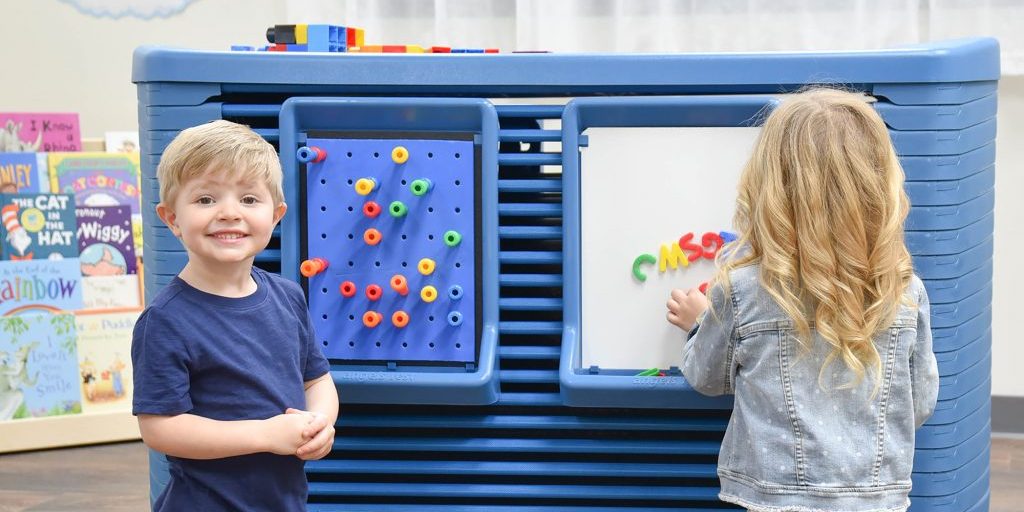
Why Arts and Crafts Are Important for Kids
Fine Motor & Bilateral Coordination Skills
Arts and crafts projects build fine motor and bilateral coordination skills as children are asked to use the small muscles in their hands and fingers during projects. Activities such as grasping paintbrushes, using scissors, and manipulating arts and crafts materials improve hand dexterity.
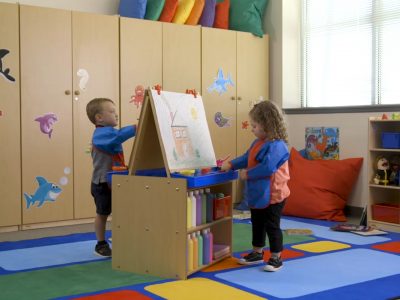
Fine motor skills during many arts and crafts projects. Indoor-Outdoor Molded Double Art Easels CF910-068 (not pictured) or Whiteboard Double Easels ANG1034 (not pictured) give kids options. Pictured here: ANG7157 Melamine Wood Art Easel for two!
When toddlers use both hands, they are essentially developing bilateral coordination skills. For example, imagine a tot needs to hold some art materials while gluing with the other hand. Children are building neural connections in the brain when two limbs are used simultaneously.
The more kids participate in activities where fine motor skills are developed, the faster they will be able to perform everyday tasks by themselves, such as eating, getting dressed, and tying shoes.
Arts and Crafts Enhance Literacy
A wide array of literacy and learning skills are enhanced when participating in arts and crafts. Children must learn to listen, understand directions, and then follow those directions. Potentially reading and speaking will be involved depending on the age group.
Children will naturally interact with their peers as they create. They will make decisions about what colors to use, discuss what the next steps in the process will be, and learn to communicate at a higher level.
The impact teachers and parents can have on a child’s vocabulary during arts and crafts activities cannot be understated. Asking children to describe the materials involved in the project during each step starts the process. Adults can then stimulate new ideas about the properties of each item so kids begin to build their database of descriptive words.
Ex. Descriptive Words:
Gritty, bubbly, bumpy, colorful, soft, furry, fluffy, hairy, fuzzy, or feathery words are a good start. Try some creamy, foamy, bright, brilliant, rich, vivid, rough, sandy, lumpy, porous, silky, or delicate words. Add some velvety, smooth, flexible, elastic, rubbery, crinkly, stringy, spongy, squishy, or wavy ones too. Mushy, clear, cloudy, opaque, dull, shiny, foggy, sparkling, gleaming, glistening, etc.
Executive Functioning – Is Your Child the Next CEO?
Focusing on developing each toddler’s executive functioning skills will impact many areas, including impulse and emotional control, memory, self-regulation, planning, organization, and task initiation skills. These skills can only be developed by giving children a bit more freedom. Micro-managing children is not the recipe for helping them become the next CEO.
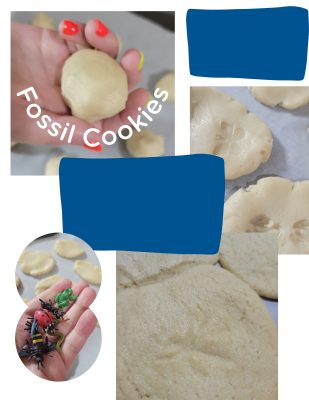
Fossil Cookies: Take this opportunity to discuss science with kids such as how fossils are formed. Use math skills to measure the ingredients necessary to make the cookies.
As they manage themselves, children will develop problem-solving skills and even enhance their ability to delegate and work as a team with other littles. These are important skills kids will use throughout their adult lives. Practice makes perfect, so there is no time like the present. Get kids started early.
Arts and Crafts Help Kids Learn About STEM Concepts
Basic math concepts are often stimulated while participating in arts and crafts. Children might be asked to cut out different shapes as part of a craft, which begins to increase their knowledge of shapes like trapezoids, rectangles, cubes, triangles, circles, ovals, and more. Projects also might require counting and sorting materials.
Visual Processing Skills & Cognitive Development
Visual processing skills are what the brain uses to see the world around us and to make sense of what we see. Our ability to process this visual data is pivotal to the learning process. We are not just talking about the ability of a child to see clearly. Kids who don’t need prescription glasses can still have difficulties with perception. Visual Processing has to do with the brain’s ability to interpret patterns and shapes. It’s how every individual learns to visually understand parts of a whole, to perceive distance and depth as well as directionality and how things are positioned in our environment.
The ability to interpret shapes helps a child learn to read and write. Discerning the difference between a “d” and a “b” or a “p” and a “q” is part of the brain’s visual processing skillset. It’s easy to see how reading and writing require these skills, but we often don’t realize how important visual processing skills are to every facet of life and every subject in school. For example, in science when kids learn about rainbows, there are many spatial factors to consider. (See our blog Are Rainbows Trendy or Timeless?) Physical education classes and playing sports like T-ball require littles to use visual processing to assess how fast a ball is traveling or to decide how much force to use when throwing the ball. (See our blog 5 Ways to Use Movement to Develop Spatial Awareness.)
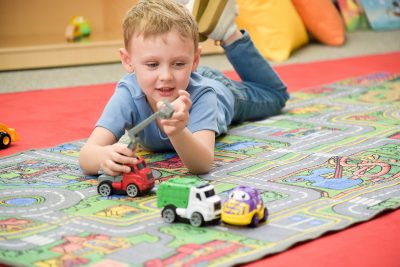
This boy strengthens his eye muscles by playing on the Giant Road Map Play Carpet. (LC719)
Strengthening eye muscles is a great way to improve visual processing skills. Avoid screen activities and apps. Hands-on activities with arts & crafts, toys, sports, puzzles, and games are the best for strengthening eye muscles. Children’s Factory has found littles love looking in the mirror and our bubble mirrors help strengthen those eye muscles as children look at themselves and process visual information around them. Hopscotch is another activity that requires littles to process visual information like how far to toss the bean bag to make it into a specific square. Road play carpets help littles strengthen eye muscles as they look from a street close to them to another street farther away when deciding where to drive next.
Creativity, Self-Esteem & Emotional Development
Rather than focusing on the outcome, it’s more important to focus on allowing kids to use their imaginations. (i.e., Doling out letter grades for art projects seems to defeat the purpose of art.) Art is meant to encourage discovery, exploration, and imagination so kids see the world in unique ways.
Arts and crafts should focus on building confidence. Parents who try to do all the work so their toddler’s crafts will look perfect on Pinterest are not helping develop their child’s sense of pride and accomplishment from finishing a project on their own. It’s pivotal to value each child’s project as worthy of praise no matter what the result. Remember, Picasso was a genius, and littles are often not far away from being little Picassos.
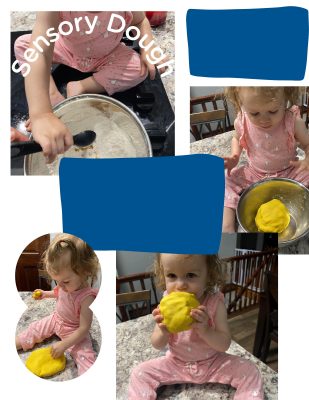
Oh the Sweet Smell of Bonding: This tot and her Mom just whipped up some Homemade Scented Play Dough for an art/sensory project.
Creative art may provide an outlet for kids to represent experiences they cannot verbalize. They might draw pictures out of proportion, which is their way of exaggerating important things. Caregivers, teachers, and parents need to be sensitive to these creative nuances.
Arts and Crafts Promote Parental Bonding
Arts and crafts provide a way for parents to tap into each child’s emotional state. As one Mom pointed out while working on creating Paper Plate Emotion Masks with her kids, “I thought only my youngest, or possibly only the two youngest, would want to participate in this craft. Oddly enough, all 3 of my kids wanted to participate. Their ages range from 7 to 14. I was surprised my 14-year-old wanted to join us, but given she is a teenager, I wasn’t surprised when the first mask she made was a ‘sad’ mask. All in all, it was fun watching the kids create masks for different emotional states like ‘nervous.”
Participating in arts and crafts together is a bonding experience and helps form memories kids will cherish for their entire lives. Kids are often focused on technology and screens. Arts and crafts projects provide positive opportunities to capture their attention.
Social-Emotional Learning
Arts and crafts hone diverse skills, including sharing, collaboration, taking turns, and showing kindness to others through praising their efforts. Children begin to identify their own unique qualities as well as the unique qualities others possess. Arts and crafts activities foster a positive self-concept while also helping children to notice and praise the positive qualities they see in others. It gives parents and teachers an opportunity to teach kids the importance of expressing kindness to others, to see each of their peers as a valued person worthy of love, praise, and respect. Hopefully, over time, kids build lifelong habits. Some behaviors are innate, and others are learned. If arts and crafts effectively build positive characteristics in our children, then we should continue using these activities to mold the next generation.
Safety First
Arts and crafts activities are not appropriate for children of all ages. Small parts and pieces pose a choking hazard to children under 3 years of age. Projects require adult supervision at all times.
Amazon Links
Wayfair Links
References:
http://squirrellyminds.com/2013/05/03/koinobori-japanese-flying-carp-diy/
https://www.buzzfeed.com/popsugarmoms/the-best-toddler-crafts-for-little-hands-arr7
https://daisycottagedesigns.net/preschool-at-home-week-2
https://happyhooligans.ca/homemade-stampers/
https://www.popsugar.com/family/Wooden-Block-Prints-25457592
https://www.popsugar.com/family/Golf-Ball-Paint-Craft-Kids-24392213
https://www.marthastewart.com/345396/fossil-cookies
https://www.popsugar.com/family/Golf-Ball-Paint-Craft-Kids-24392213
https://www.popsugar.com/family/Bubble-Wrap-Painting-24586969
https://happyhooligans.ca/stamped-flower-craft-corks-and-buttons/
https://activity-box.com/6-reasons-why-art-and-crafts-are-so-important-for-child-development
https://www.oecd.org/education/ceri/31709587.pdf
https://www.newhorizonsvisiontherapy.com/what-is-visual-processing/
https://yourkidstable.com/visual-perceptual-activities/
https://www.notimeforflashcards.com/2011/05/paper-plate-emotion-masks.html